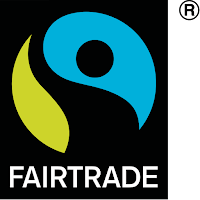Marketing fair trade research
Pre-production research- Fair Trade
This Starbucks advert uses the contractions 'we've' and 'we're' to show the informality of their advert. This informality shows that they want to appear more informal to their customer base. They use the simple sentence 'We've always been crazy about coffee.' to get their point across about their coffee now being fair trade. The colour palette they have used shows a more earthy and nature like theme. These specific colours have been used to refer to fair trade, which help farmers get a fairer price for their products. The fair trade logo is used in the center of the page to show the importance of it. This also allows the reader to understand the advert more with the image as the reference. The asterisk is used to indicate to the reader that their is more information about what the company is now 'certified' for. Which is '100% of our espresso beans are now Fair trade certified.' The advert uses all capital letters in the text to draw the reader attention to the advert. The use of the capital letters may make the advert easier to read. Each line of the text is written in a different font. This may be used to make the company seem more unique with what they do.
This Ben and Jerry's ice cream advert uses the image of one of their tubs with a vanilla farm on the inside of it. The use of the scenery in the picture makes the reader think that by buying the fair trade products the workers on the farms will have an instantly better quality of life. The first heading 'Made with fair trade vanilla'. uses bold text to show that it is important. It is not grammatically correct, due to their not being any punctuation, it is also all in capital letters, which makes it easier to read. The simple sentence 'It's what's inside that counts.' uses the contractions 'It's' and 'what's' this is to create an informal and friendlier approach onto the product being fair trade. The smaller text at the bottom of the page is about someone who inherits a vanilla bean farm, that is then created into being fair trade to allow the farmers to get a fair price for the products.

This co-operative advert uses simple declarative sentences for example: 'Better schools in Panama' , 'Improved farming in Ghana' and 'Cleaner water in Africa'.
They have used these sentence types to tell the reader what can happen if they buy a certain product, or if they donate a certain amount of money. The images are at the center of the page, this draws the readers attention to the images. The first image (Left) is of a banana and a pencil that has been conjoined. The reason for the different images to be put together is to show that for Panama to have better schools we can also get a free banana for only 39p. The second image (Middle) is of a coffee bean and also a wrapper. This shows that for improved farming in Ghana we can get a free Easter egg for £2.99. The third image (Right) is of a wine glass with water in it. This shows that Africa can access cleaner water for £3.49 and we can get a bottle wine. The co-operative logo is at the bottom of the page, which tells the reader which brand is being advertised.
This Cadbury advert uses cartoon images of cocoa beans which are dancing and playing instruments. The fairtrade logo is clearly visible on the advert. The catchphrase 'a GLASS and a HALF FULL GHANA PRODUCTION' draws attention to the fact that the product is fair trade and they are helping farmers get a better price for their goods/ products. Very little punctuation is used on the advert, which may indicate that the brand is trying to come across as friendly and informal. The exclamative 'yum' is repeated twice. The advert has aspects of being aimed at children through the images and the simple and minor sentences. However the advert would be aimed at an older generation so that they would buy it and also know what fair trade is.
http://www.fairtrade.org.uk





Comments
Post a Comment